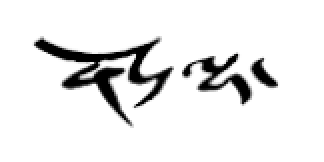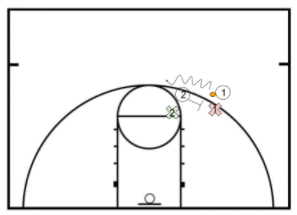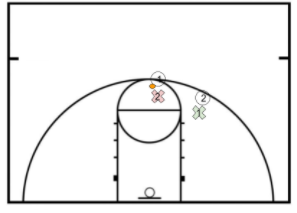Contents > 2. Defense > 2.1. Player-to-Player, 1/4 Court Defense > 2.1.4. Combined Defensive Situations > 2.1.4.1. Defending Screens > 2.1.4.1.1. Defending Screens: On-Ball >
2.1.4.1.1.1. Defending Screens: On-Ball Switch
(1) Q: What is “switching” on-ball screens
A: Switching on an on-ball screen means the on-ball defender getting screened switches their defensive assignment from the ball-handler to the screener. The defender who’s original assigned player is the screener will switch to the ball-handler. This is the quickest and simplest method of defending screens, though it has some considerations.
(2) Q: What should the defender who’s assigned player is screening do when switching?
A:
1. Communicate: This defender must first communicate about the screen! This defender will yell to the on-ball defender getting screened that a screen is coming, either from the left or the right (e.g. “Screen left!”). If the defender does not communicate this, the on-ball defender will have no idea the screen is coming, which will lead them to not being prepared for the screen (and also may cause injury). This defender must also communicate that a switch will be occurring (e.g. “Screen Left! Switch!”).
2. Switch Defensive Assignments: After the screen has been set, this defender will now become the on-ball defender
3. No Middle: like normal on-ball defensive principles, the new on-ball defender must now prevent the ball-handler from going to the middle
4. Prevent Screen and Roll Pass: if the offense performs a screen and roll, this new on-ball defender must make the pass to the roller difficult by putting their hands in the passing lane.
(3) Q: What is a screen and roll?
A: A screen and roll is when after setting the screen, the screener “rolls” off the defender, many times sealing the defender behind them, allowing for an open lane to the basket.
(4) Q: What is a seal on a screen and roll?
A: A seal is similar to a box-out, keeping a player behind you. After setting a screen and rolling, the screener will try to keep the defender they just screened behind them, sealing them.
(5) Q: What should the defender getting screened be doing during a switch?
A: Once the on-ball defender realizes a screen is coming, they can either go under the screen or go over the screen to now get in between the ball-handler and their new assigned player (the screener) for deny defense. Staying behind the screener (not attempting to go over/under the screen, aka getting sealed) will allow for an easy screen and roll.
(6) Q: When should we switch on on-ball screens?
A: Switching on on-ball screens is best to use when the pair of defenders are of similar size (for instance, two guards or two posts). If they are different sizes, a guard may end up defending a post player, or vice versa. This is called a mismatch. The offense will most likely utilize the screen and roll, in which case the roller will have the mismatch with a large post player being guarded by a smaller guard in the post area. The ball-handler (a guard) may also end up with a larger post player defending them, allowing the ball-handler to dribble past the usually bigger defender, or if the bigger defender is playing farther back because they are slower, the ball-handler will have more space for an open shot.
(7) Q: What should help defense be doing during a switch of on-ball screens?
A: Since the screen and roll is usually the most dangerous threat out of the switch, there MUST be help inside the key during the screen to prevent an easy pass to the roller. The help defense must be able to prevent the pass to the roller, and also be able to contest an outside shot by their assigned player.
(8) Q: If the defenders are similar size, what are the advantages of switching on screens?
A: Switching allows the defense to always have someone defending the offensive player being screened (in this case, the ball-handler) since the switch occurs immediately.
SKILLS DRILLS
Skills Drill #1 - 2v2 Defending On-Ball Screen, Guard to Guard (Switch)
O2 will start with the ball at the top of the key. X2 will be defending on-ball. O1 will be on either wing, with X1 in deny defense.
O2 will pass the ball to O1, then set an on-ball screen. The defense will switch, X2 now defending O1, and X1 now defending O2.
First, walk through this to ensure understanding. Then, play live 2v2 with an on-ball screen and switching. Offense has 7 seconds to score.
Skills Drill #2 - 3v3 Defending On-Ball Screen, Guard to Guard (Switch)
The same as Skills Drill #1, however now O3 will be in the opposite corner (stationary), and X3 will be in help defense.
Walk through first to ensure understanding, then play live 3v3 with an on-ball screen and switching. Offense has 7 seconds to score.














